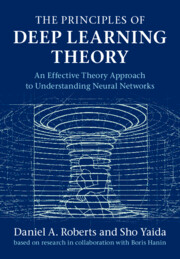Crossref Citations
This Book has been
cited by the following publications. This list is generated based on data provided by Crossref.
Nikolov, Miroslav
Tsenov, Georgi
Nakov, Ognyan
Lazarova, Milena
and
Mladenov, Valeri
2022.
Application of GPU Accelerated Deep Learning Neural Networks for COVID-19 Recognition from X-Ray Scans.
p.
1.
Gu, Jing
and
Zhang, Kai
2022.
Thermodynamics of the Ising Model Encoded in Restricted Boltzmann Machines.
Entropy,
Vol. 24,
Issue. 12,
p.
1701.
Lee, Jongsub
and
Yun, Hayong
2022.
Learning Production Process Heterogeneity Across Industries: Implications of Deep Learning for Corporate M&A Decisions.
SSRN Electronic Journal ,
Zavatone-Veth, Jacob A.
Tong, William L.
and
Pehlevan, Cengiz
2022.
Contrasting random and learned features in deep Bayesian linear regression.
Physical Review E,
Vol. 105,
Issue. 6,
Kam Ho, Tin
2022.
Complexity of Representations in Deep Learning.
p.
2657.
Holmes, Dawn E.
2022.
Advances in Selected Artificial Intelligence Areas.
Vol. 24,
Issue. ,
p.
103.
Canatar, Abdulkadir
and
Pehlevan, Cengiz
2022.
A Kernel Analysis of Feature Learning in Deep Neural Networks.
p.
1.
Tiberi, Lorenzo
Stapmanns, Jonas
Kühn, Tobias
Luu, Thomas
Dahmen, David
and
Helias, Moritz
2022.
Gell-Mann–Low Criticality in Neural Networks.
Physical Review Letters,
Vol. 128,
Issue. 16,
Fischer, Kirsten
René, Alexandre
Keup, Christian
Layer, Moritz
Dahmen, David
and
Helias, Moritz
2022.
Decomposing neural networks as mappings of correlation functions.
Physical Review Research,
Vol. 4,
Issue. 4,
Li, Lianlin
Zhao, Hanting
Liu, Che
Li, Long
and
Cui, Tie Jun
2022.
Intelligent metasurfaces: control, communication and computing.
eLight,
Vol. 2,
Issue. 1,
Ma, Yi
Tsao, Doris
and
Shum, Heung-Yeung
2022.
On the principles of Parsimony and Self-consistency for the emergence of intelligence.
Frontiers of Information Technology & Electronic Engineering,
Vol. 23,
Issue. 9,
p.
1298.
Marchand, Tanguy
Ozawa, Misaki
Biroli, Giulio
and
Mallat, Stéphane
2023.
Multiscale Data-Driven Energy Estimation and Generation.
Physical Review X,
Vol. 13,
Issue. 4,
Thottolil, Rahisha
Kumar, Uttam
and
Chakraborty, Tanujit
2023.
Prediction of transportation index for urban patterns in small and medium-sized Indian cities using hybrid RidgeGAN model.
Scientific Reports,
Vol. 13,
Issue. 1,
Liu, Junyu
Najafi, Khadijeh
Sharma, Kunal
Tacchino, Francesco
Jiang, Liang
and
Mezzacapo, Antonio
2023.
Analytic Theory for the Dynamics of Wide Quantum Neural Networks.
Physical Review Letters,
Vol. 130,
Issue. 15,
Niraula, Dipesh
Sun, Wenbo
Jin, Jionghua
Dinov, Ivo D.
Cuneo, Kyle
Jamaluddin, Jamalina
Matuszak, Martha M.
Luo, Yi
Lawrence, Theodore S.
Jolly, Shruti
Ten Haken, Randall K.
and
El Naqa, Issam
2023.
A clinical decision support system for AI-assisted decision-making in response-adaptive radiotherapy (ARCliDS).
Scientific Reports,
Vol. 13,
Issue. 1,
Marchand, Richard
Shahsavani, Sadaf
and
Sanchez-Arriaga, Gonzalo
2023.
Beyond analytic approximations with machine learning inference of plasma parameters and confidence intervals.
Journal of Plasma Physics,
Vol. 89,
Issue. 1,
Barr, Joseph R.
and
Haass, Jon C.
2023.
Machine learning: a personal tour.
p.
179.
Hanin, Boris
2023.
Random neural networks in the infinite width limit as Gaussian processes.
The Annals of Applied Probability,
Vol. 33,
Issue. 6A,
Mokkapati, Ragini
and
Dasari, Venkata Lakshmi
2023.
A Comprehensive Review on Areas and Applications of Artificial Intelligence, Machine Learning, Deep Learning, and Data Science.
p.
427.
Shen, Xuan
Wang, Yaohua
Lin, Ming
Huang, Yilun
Tang, Hao
Sun, Xiuyu
and
Wang, Yanzhi
2023.
DeepMAD: Mathematical Architecture Design for Deep Convolutional Neural Network.
p.
6163.



